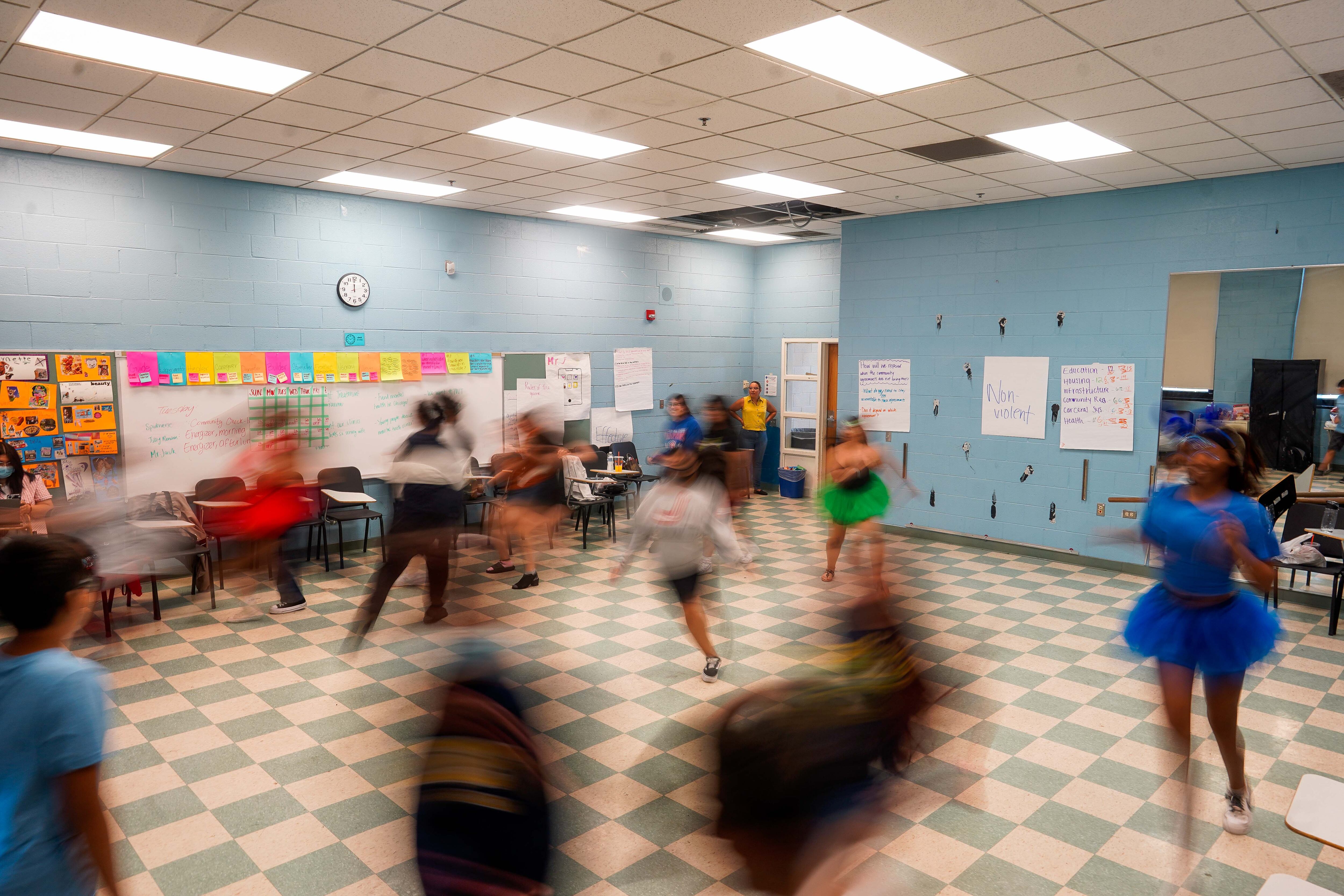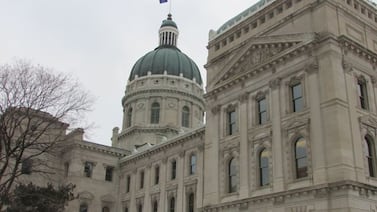Sign up for Chalkbeat Chicago’s free daily newsletter to keep up with the latest education news.
Kia Banks, the principal at Vanderpoel Humanities Academy on the city’s South Side, found out this summer her school was getting less than a third of the funding it received last year to run after-school programs.
Last school year, she was able to pay Vanderpoel teachers to stay after school to help students who were behind in math and reading, and to provide mentoring. The arts magnet also brought in outside organizations to run music and art programs.
Banks credits these offerings with boosting a sense of community and connectedness on the small campus, which has a predominantly Black and majority low-income student body.
But with funding slashed from about $32,000 to less than $10,000 for this coming school year, Banks will likely have to scale back these programs.
After pouring federal COVID relief dollars into a once barebones budget for such programs, Chicago Public Schools is now cutting funding for academic, arts, sports and mentoring before- and after-school programs, labeled as Out of School Time. This summer, the district touted a 2024-25 budget that “doubles down” on a COVID-era spending boost for extracurricular programs, which officials said has sped up students’ recovery. But in fact, funding for these programs is down by roughly a third, to about $31 million.
Banks said she and other school leaders were bracing for the cuts because they knew the district’s $2.8 billion in COVID relief would be running out this year and a sizable deficit loomed. Still, some principals said they were taken aback by dramatic reductions that might force them to scrap dozens of programs. Some are scrambling to find new ways to pay for them.
CPS officials said they used the district’s Opportunity Index — a metric of a school’s level of need that factors in student demographics and other data — to steer Out of School Time dollars to campuses serving the most vulnerable students. They argued that overall, schools should be able to continue serving roughly the same number of students as they did last year, based on an analysis of program attendance and cost this past school year.
Some officials say schools can lean more on community-based organizations to provide programming, sometimes at a relatively low or no cost to schools. But some principals say Out of School Time dollars offered a key advantage: the ability to pay their own teachers and support staff to run extracurricular programs, helping forge stronger relationships and improve school climate.
“I don’t think there’s any way to replicate having your own staff provide these opportunities,” said Banks, who is also the chief of staff at the Chicago Principals and Administrators Association, the union representing school leaders in CPS.
Still, she said, “The fact that those allocations are decreasing shouldn’t be a surprise to anyone. The money is just no longer there.”
The CPS shift comes at a time of larger uncertainty around after-school programs in Illinois: A federal grant that allows schools to enlist community organizations to provide extracurricular programs is expiring on campuses in Chicago and across the state. Last spring, Illinois lawmakers approved $50 million for after-school and summer programs, but the money hasn’t yet started flowing to schools.
The district did not provide school-by-school Out of School Time allocations to Chalkbeat, despite multiple requests. It said only that schools received an estimated $42,000 to $65,000 in this year’s budgets.
More than a half dozen schools where Chalkbeat connected with a local school council or school leader reported much smaller amounts; a district spokeswoman said both the upper and lower end of that range are average amounts.
Some principals were shocked by drastic cuts
One Chicago principal said expanded Out of School funding was a boon to her campus, where more than 90% of the student body is low-income. Last year, the school offered more than two dozen academic, arts, sports and other programs before and after the school day. These programs kept the doors open from 7:15 am to 6 p.m. and helped students and families feel more connected to the school and its staff.
But in June, the principal, who asked to remain anonymous to speak freely about the issue, found out this year’s budget included less than a quarter of the funding — a cut she called “heartwrenching.” She estimates the money will allow the school to keep only three of its programs and offer them only two days a week.
She said an already tight budget means there are no discretionary dollars she can steer toward saving these programs. And the school faces a double whammy as a federal grant for community-based programming expires as well.
She has been asking community members if they would volunteer to run programs without pay, and she has reached out to state lawmakers representing her district to see if they can help.
“The district kept saying, ‘Have rigorous, high-quality programs.’ ‘Keep your kids engaged,’” the principal said. “Losing that money is going to be a huge detriment to our students.”
The cuts come on the heels of a major pandemic-era expansion. The district spent less than $5 million for Out of School programs in 2017-18 and served about 40,000 students. By last school year, federal COVID relief had boosted that spending to $46 million, with 115,000 students taking part in programs across the district. CPS touted these numbers at a public bargaining session with the Chicago Teachers Union focused on the student experience last week.
In recent years, extra pay for staff overseeing extracurricular programs has come under scrutiny by the district’s Office of Inspector General as spending on those programs has swelled. The office has flagged employees who earned what inspectors deemed excessive extra pay and schools that could not provide timesheets, but there is no indication the recent cuts are connected to these investigations.
How some school leaders are adapting
Banks, of the Chicago Principals and Administrators Association, said Out of School funding was invaluable in supporting post-pandemic recovery — but the district was always clear about using one-time COVID relief money.
“There was never any promise by the district of, ‘We are going to fund these programs in this way forever,’” she said.
She said schools still have some options, such as tapping low-cost vendors vetted by the district — and the union is there to help troubleshoot. Banks said her school will likely provide programs only in the second and third quarter of the school year and only for some grades.
“We’ll be much more targeted and specific this year,” she said.
Another principal said his school’s Out of School Time funding also shrank to less than a quarter of what it was last year. Now, with only about $15,000, 30 programs are in question. He said he hopes parent fundraising can make up the difference to keep the programs, which have strengthened students’ relationships with peers and school employees at a time when absenteeism and mental health issues remain heightened post-pandemic.
Joanna Su, who recently wrapped up her service on the local school council at Gale Community Academy in Rogers Park, will lean more on a close relationship with Loyola University and other local organizations to support its after-school programming. The school’s funding was cut roughly in half, to $11,000.
“We are fortunate to have lots of great community partners,” Su said, “but I don;t know that every school has that luxury.”
Patrick Brosnan of the nonprofit Brighton Park Neighborhood Council, which teams up with schools to provide extracurricular and other programs, said most of the group’s partner campuses are also facing budget constraints. The $50 million for community schools the state approved earlier this year was a “huge victory,” he said. But he and others are frustrated that it’s taking some time to push out the funding to schools. The nonprofit might use private fundraising to prevent layoffs and cuts, he said.
“We are trying to figure out how to continue to fund programs,” he said. “It’s a scarcity mindset, and it’s too bad we’re in this situation.”
Mila Koumpilova is Chalkbeat Chicago’s senior reporter covering Chicago Public Schools. Contact Mila at mkoumpilova@chalkbeat.org.






